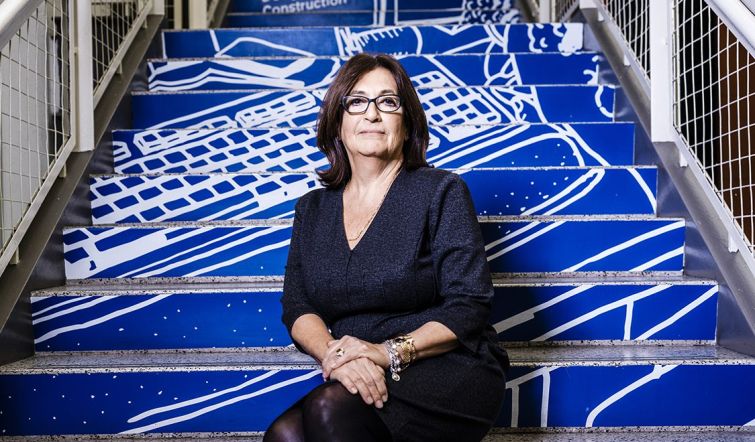DDC Commissioner Lorraine Grillo on Trying to Turn Around the Delay-Plagued Agency
Lorraine Grillo doesn’t fear a challenge, because the NYC School Construction Authority president has also taken control of the DDC—a very thankless task
By Nicholas Rizzi April 16, 2019 10:30 am
reprints
New York City School Construction Authority President (SCA) and CEO Lorraine Grillo had her work cut out for her when she accepted Mayor Bill de Blasio’s offer last June to divide her time and take charge of the Department of Design and Construction (DDC).
The little-known city agency, created in 1996 by Mayor Rudy Giuliani, currently manages $13.5 billion of capital projects around the five boroughs, tasked with handling everything from street repairs to new recreational facilities. But in recent years it has drawn the ire of local politicians and residents frustrated by the long delays and ballooning costs of its projects.
Grillo countered that government red tape, the media’s focus on problem projects and DDC’s poor communication with the community were in large part to blame.
“What’s on time for us may not be on time for someone else,” she said. “For example, we know that when we open up [a] street, National Grid [the gas utility company] has to repurpose their lines. I don’t have the leverage to say, ‘you have to do this tomorrow.’ ”
But the DDC critics have not been entirely without merit. A 2017 Center for the Urban Future (CUF) report looking at library, museum and performing arts projects managed by the DDC found that they on average took more time and money to finish than if the institutions handled them.
The 144 DDC-managed projects the report tracked between 2010 to 2014 took a median of four years to build—with some taking more than seven years—while the median cost was $930 per square foot, more than double the average price tag to build new office space in the city.
“For so many years, DDC has been at the center of a broken capital system,” said Jonathan Bowles, the executive director of CUF. “A lot of these are needless delays.”
Long delayed DDC projects dot the entire city. The DDC-managed Hunters Point Community Library in Long Island City, Queens, is finally set to open this summer after almost 10 years of planning, four years of construction and a staggering $1,700 per square foot. The renovation of the Animal Care Center of Staten Island, which broke ground in 2013, had its projected cost surge to $8.2 million from $3.1 million, The New York Post reported.
During a 2016 City Council meeting about the East Elmhurst, Queens, library renovation, then-Councilwoman Julissa Ferreras-Copeland complained it was “discouraging” for council members to fund DDC projects because “it often doesn’t even happen within our term of being elected,” DNAinfo reported.
“I think we need to get an accurate picture of how many [projects] we have in this vicious cycle of [inefficiency] and then we can figure out how we’re going to approach this,” she said, according to DNAinfo.
Staten Island Borough President James Oddo has been an active critic of the agency, constantly slamming it on Twitter (he questioned whether, at a meeting with the agency in 2017, “it was an Abbott and Costello routine or just sheer incompetence”) and launching a game on his website in 2016 that let Staten Islanders vote if individual DDC-managed projects would finish on time or be delayed.
But all that appears to be changing under the auspices of the Astoria native, Grillo, whose SCA shares the same Long Island City office building as the DDC. She tries to split her time equally between both agencies—admitting recently to spending more hours at DDC—and has senior staff in both helping to run the day-to-day operation when she’s gone.
“There’s nobody in the world who could do it better than she could,” said Melanie La Rocca, the vice president of operations at the SCA who’s worked with Grillo for five years. “There’s truth to the folklore. I think she is legitimately as good as people say she is.”
Grillo can be seen walking the distance of a city block between her two offices several times a day—she recently downloaded an app to track her steps—and immediately got to work developing a plan with the DDC staff to minimize delays and streamline the agency.
“There is a lot of talent here,” Grillo said. “There are a lot of really, really good people and, in a lot of cases, they were getting a very bad rap and they deserve better. And so that’s my goal.”

The DDC released a plan, dubbed “A Strategic Blueprint for Construction Excellence,” in January that outlines 10 fixes for the agency. It calls to modernize the agency’s pre-construction phase, create technology to better track timelines, continue to pay contractors during budget increases and notify the community of any snags along the way.
“[The plan] isn’t a matter of cutting corners, it is a matter of doing things better and doing things in a better way,” Grillo said. “And also getting the other agencies—the sponsor agencies as well as the oversight agencies—to agree we could all work together to make this work.”
The CUF report found that 86 percent of the delays on DDC projects it tracked happened in the pre-planning phase. Grillo’s plan aims to address that by expanding the agency’s front-end planning unit so it performs an early review of all DDC work and streamlines the oversight process undertaken by the city’s Office of Management and Budget (OMB) before work can start.
Michael Greenberg, a spokesman for OMB, said in a statement that his agency will “now join DDC in piloting the use of allowances for unforeseen work to reduce delays related to change orders.”
The DDC is also working with the state legislature to get authorization to use the design-build process—which lets the DDC hire a single contractor to design and do the work and cuts down on costs and construction time—instead of the current design-bid-build which requires it puts the construction and design phases up for bidding.
“We would love a blanket approval to design-build, where it makes sense,” she said. “It doesn’t always make sense, but it’s good to have the option there.”
A major change that prevents delays once construction starts was made to the change-order process.
Before, when the DDC needed more money to finish capital projects than was originally approved, it was a logistical nightmare involving OMB and Comptroller Scott Stringer’s office. It could take up to nine months with construction grinding to a halt because the DDC wasn’t allowed to pay contractors during it, Grillo said.
Grillo worked with OMB and Stringer’s office to develop a pilot launched in January that allows the DDC to continue paying contractors to keep working on a project while the change order goes through.
A spokeswoman for Stringer did not respond to a request for comment.
“That’s very important, particularly for our small MWBE [minority and woman-owned business enterprises] contractors,” Grillo said. “Having to wait nine months for a payment could put them out of business.”
That problem has been especially noticeable during infrastructure projects because crews constantly find unforeseen construction issues once they rip up streets, according to Grillo.
Another key component of the plan, Grillo said, is simply having more communication between the agency and locals. The DDC is appointing staff to act as dedicated liaisons for each borough—starting with a satellite office in Staten Island—so they can keep people informed before a construction stop.
“Having that ability to communicate with the person that lives on that street and say, ‘Look, we’re waiting for National Grid. As soon as they come in we will continue our work. It will be done in X amount of months or weeks,’” Grillo said. “That means a lot to people. It really, really does.”
While the changes are only a few months old, they have already won over some of the DDC’s toughest critics. Oddo has largely ceased his attacks on Twitter and instead heaps praise on Grillo. Grillo said they developed a great working relationship during her time at the SCA.
“If there is a more ardent admirer of Lorraine Grillo in city government I would like to know who that person is,” Oddo said in a statement provided to Commercial Observer. “I respect Lorraine. I admire Lorraine. My affinity for her has been forged by years of working with her and seeing her deliver on the commitments she has made to Staten Islanders and New Yorkers.”
“Lorraine is an immediate injection of leadership, accountability and professionalism into an agency whose mission is to see New York City build on time and on budget,” he added.
Bowles said the CUF—a nonprofit focused on expanding economic opportunities in the city—has written plenty of reports pointing out flaws in city agencies over the years, but rarely has one agency head responded so thoroughly to its recommendations as Grillo at DDC.
“I give her immense credit for coming in and taking ownership of this problem and setting a fairly bold plan,” he said. “It’s really refreshing.”
Some DDC staff members reported a renewed sense of optimism within the agency that it could finish projects on time and stop being the city’s punching bag. However, one longtime employee said despite what looks like a solid plan, the buzz around the office has been that folks are uncertain anything will actually change.
“It looks good on paper, but in practical application is it going to work?” said the staffer, who spoke on the condition of anonymity for fear of losing his job. “I don’t think the confidence level is there.”
“It comes across more as rhetoric for the city,” he added. “It really needs to see practical application.”
Bowles said that while the DDC addressed most of the issues highlighted in the CUF report, it’s going to need a lot of support from other city agencies to really turn things around.
“I think only time will tell if they’re able to really make significant progress or if their proposals are all the right ones,” he said. “The big question mark is the level of support they get from OMB and their partner agencies.”
Another DDC staffer pointed out that the changes have already produced results. He mentioned one project that would’ve snarled and gotten plenty of negative ink in the tabloids without the new process but declined to provide specifics.
Feniosky Peña-Mora, who stepped down as the commissioner of the DDC in 2017 to return to Columbia University, praised Grillo and said the changes she suggested got at the heart of the challenges he faced while at the agency.
“Lorraine is doing an amazing job,” he said. “I think she’s is bringing such fresh thinking to the agency to really push this [plan] to achieve this success that is needed for all New Yorkers.”
But even if not every DDC worker is convinced Grillo will actually bring change, many feel she’s still a better fit for the agency than the previous commissioner.
While de Blasio applauded Peña-Mora for increasing the number of contracts MWBE companies received, and overseeing the DDC during a big period of growth, one staffer complained that Peña-Mora further slowed down the agency by micromanaging the work.
The DDC staffer described Peña-Mora as brilliant with numbers but refusing to take responsibility for delays or mistakes the agency made.
Peña-Mora came under fire when DNAinfo reported he used city funds to pay a magazine publisher, Sacks Communications, to dedicate an entire issue of Diversity/Agenda to his accomplishments and hired Councilman Ydanis Rodriguez’s wife as his special assistant with a $150,000-a-year salary.
Peña-Mora, who was never charged with wrongdoing, told CO the DNAinfo stories were “totally inaccurate” and feels proud of his time at the agency.
“I did the best to my abilities with the best of intentions,” he said. “I can sleep well every single night of my life.”
Employees describe Grillo as having a warm demeanor—telling workers to call her by her first name instead of commissioner—and is open to ideas pitched to her by them.
“She is the quintessential Italian mother,” the staffer said. “She is a wonderful human being to speak with and deal with.”
Across the hall, workers at the SCA said Grillo has an open-door policy and always has time to chat, be it ideas for the agency or simply about their children.
“I don’t know how many other bosses you can walk into their office and say, ‘Hey, I have an idea,’ ” La Rocca said. “She knows everybody here, she knows everybody’s name, she knows about their lives. This is not a small operation and that speaks to her style.”
La Rocca added that Grillo created a work environment where she trusts her employees to do their job and make decisions. She sets a tone to work hard, with high expectations, along with laughter.
“I think she’s probably one of the best bosses I’ve worked for and I think that’s a pretty common feeling around here,” she said. “She’s probably one of the smartest people around.”
Peña-Mora added that Grillo was one of the first people he consulted about how to run a city agency when he helmed the DDC in 2014.
Part of Grillo’s goal when taking over the DDC was to start a “culture change” in the notoriously toxic agency to make it feel like the nearby SCA. One of her mantras is “project delivery” and she wants to inspire staff that they can get capital projects over the finish line and on time.
“We can win, we can deliver,” Grillo said. “There’s no reason why we can’t do this faster and better and get the accolades that these folks deserve.”
Running two agencies each responsible for more than $10 billion of construction in all five boroughs might be a Herculean feat, but Grillo has proven up for the challenge and the staff at the SCA has barely noticed her absence.
“I don’t really know how she does it, but she does it with grace and style,” La Rocca said. “I personally do not think that she is any less reachable, approachable or anything. It’s not like a monumental change.”
Grillo—who would not provide her age—got her start in city government 25 years ago when she joined the then-recently formed SCA, responsible for building or improving public schools around the city.
“We were inventing it, all of us,” she said. “We all rolled up our sleeves and we put together these processes and got it started. That’s what made me committed to the SCA.”
She eventually rose to become president of the SCA in 2010, appointed by then-Mayor Michael Bloomberg and was reappointed by de Blasio in 2014, one of only two reappointments between the two administrations, according to the mayor’s office. (The other was Office for People with Disabilities Commissioner Victor Calise in 2015.)
While in charge at the SCA, Grillo brought it a good reputation for delivering projects on time and on budget, Bowles said. During her time, the SCA finished more than $25 billion of construction projects, added 75,000 new school seats all while never missing a school opening, according to de Blasio’s office.
“She can manage an agency effectively at School Construction Authority,” he said. “They do have a pretty good rep for managing capital projects.”
After Peña-Mora left the DDC, de Blasio asked Grillo to come up with several proposals for how the city could turn the agency around. She later submitted a list of suggestions outlining some potential changes, which was her “ticket into the door,” and he asked her if she’d be willing to split her time with the agency, taking over from acting commissioner Ana Barrio.
“Lorraine Grillo is universally admired as someone who gets it done,” de Blasio said in a statement. “She’s proven it with 75,000 new school seats and now she is going to prove it on our streets and public buildings.”
The decision to handle both wasn’t a difficult one for Grillo. She saw the potential the DDC had and was excited to breathe new life back into the agency.
“The folks here needed the encouragement to know that they’d be heard and that we can certainly do better in terms of showing people what we can do,” she said. “It’s very exciting to see this happening.”


